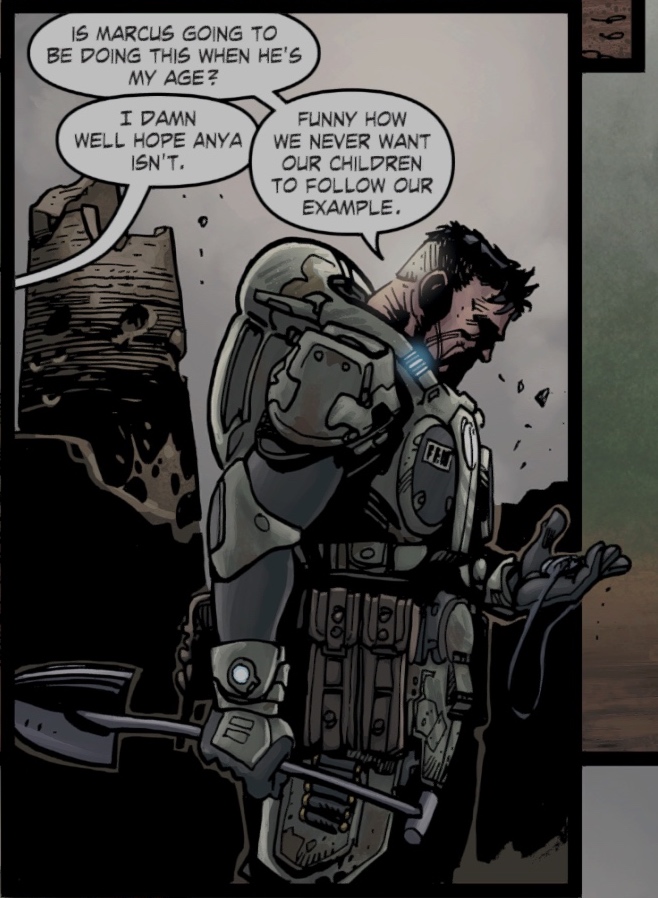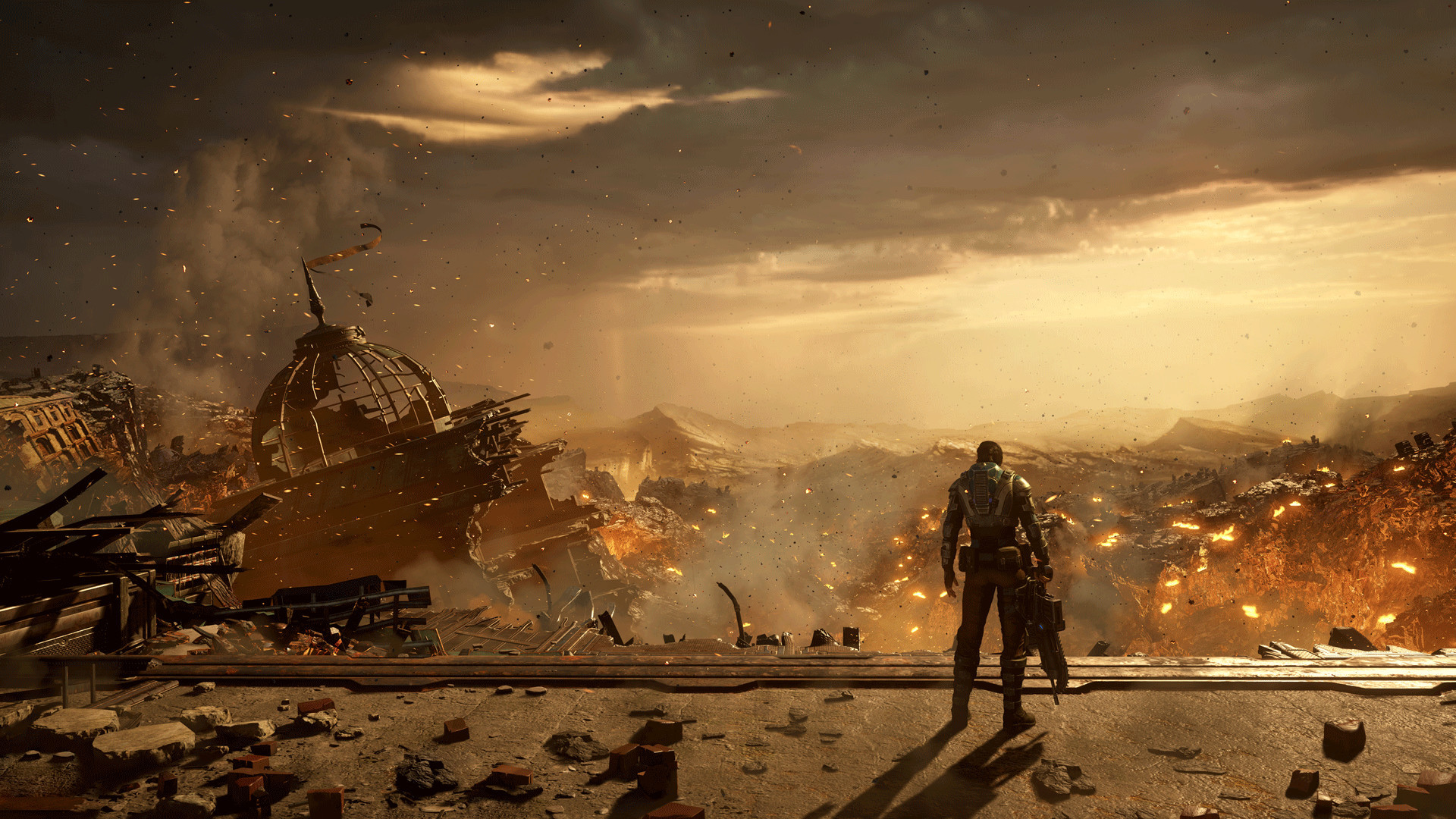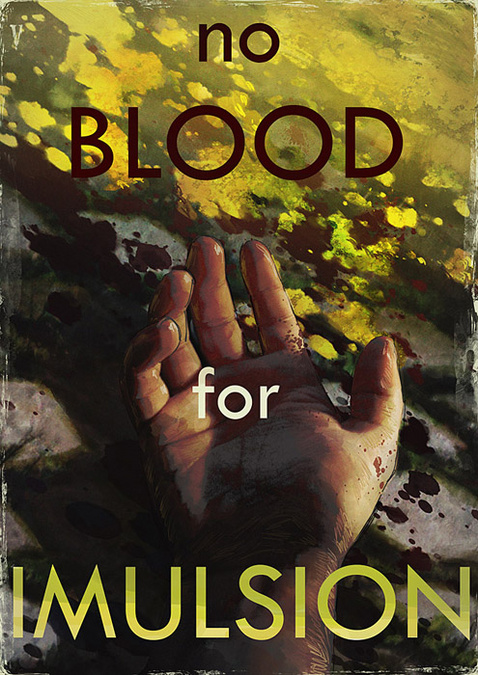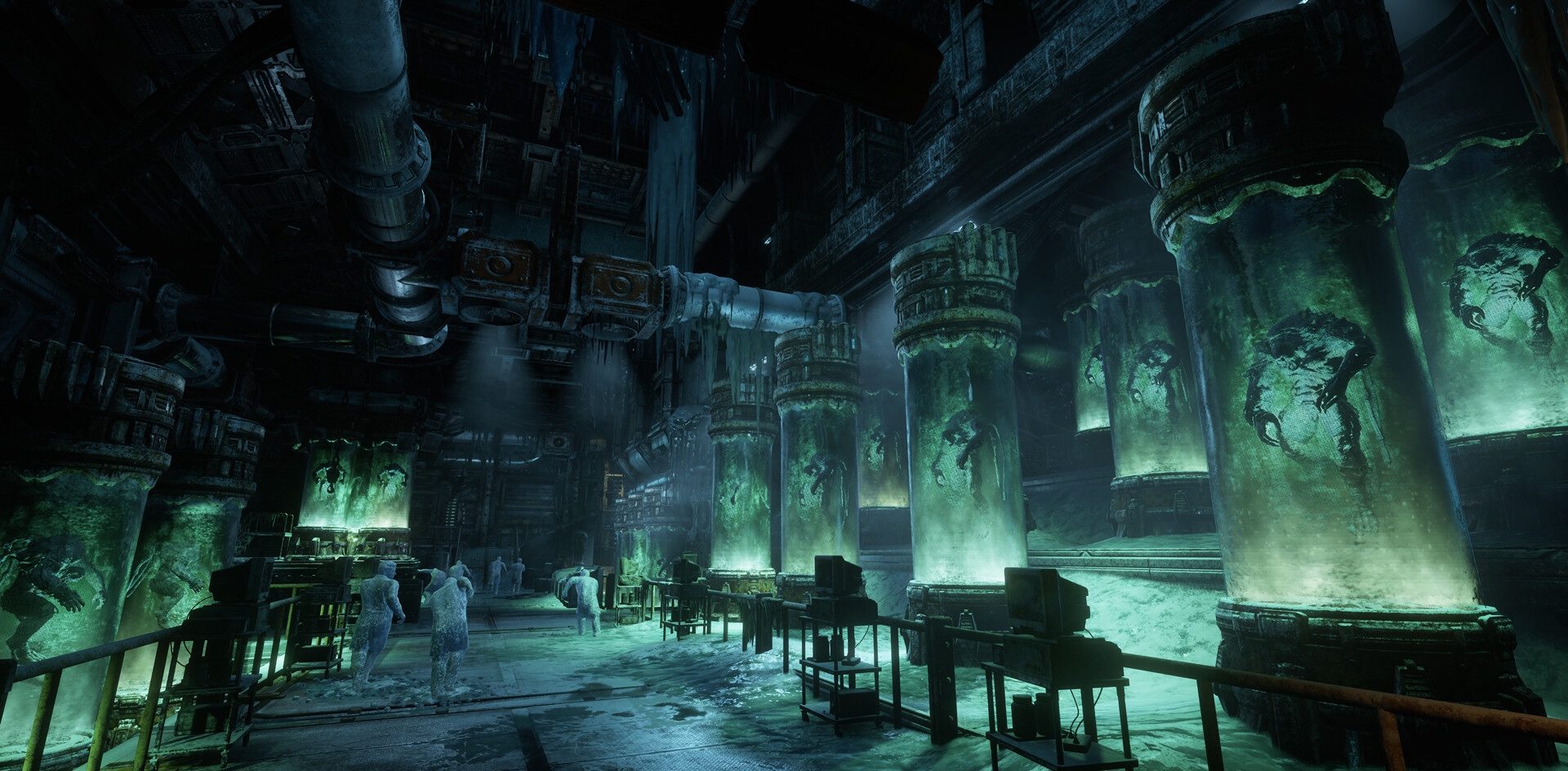Early on in Gears 5’s campaign, an aging, gray-bearded Marcus Fenix says something that sounds like it was torn out of the pages of a Second Amendment rights pamphlet: “It’s not the weapons I don’t trust, First Minister,” he tells Jinn after she expresses concerns about resurrecting the Hammer of Dawn weapon system. “It’s the people who use them.” In other words, satellite-powered superweapons don’t kill people; people kill people.
It’s a statement that stands out because the ethical use of WMDs is rarely something that’s discussed in the series. As often as Gears of War shows the human cost of war, it never really broaches the moral questions that come with global conflict, nor is the deep political and scientific world-building mined for overt commentary. But, at its core, and from its inception, Gears of War has always been a parable of the dangers of the military-industrial complex.
Marcus is something of a political cypher in the Gears of War universe. The first time we meet him, he’s four years into a 40-year prison sentence in the Slab, branded a traitor by the Coalition of Governments for abandoning a mission to save his father. And when he’s acknowledged by Anthony Carmine as a hero of the Battle of Aspho Fields—the victory that enabled the COG to secure the Hammer of Dawn from its Pendulum Wars enemy, the Union of Independent Republics—Marcus comes off resentful at being labeled a living legend.

Credit: Xbox Game Studios
Our initial impressions of Marcus as a bruised and battered COG grunt with a major chip on his shoulder and an anti-establishment streak carries throughout the series, even as he rises back up the ranks of the army and eventually ends up saving humanity. Marcus Fenix’s consistent truth is that he hates the Locust above all else, but that doesn’t mean he’s in love with the COG either. When we find him again in Gears of War 4, he’s living outside the COG’s political machinations, tending to his family’s manor. That is, until Jinn and the rest of the COG spend the next hour or two trying to murder him, his Gear-turned-Outsider son J.D., and his son’s friends Del and Kait. Throughout the series, Marcus’ motivation to fight was one of survival and keeping his loved ones safe; it had nothing to do with politics or patriotism.

Credit: Wildstorm
That’s, of course, if you only know Marcus Fenix from the games. The Marcus Fenix that’s seen in the Gears of War comics set prior to the events of the games, show a somewhat different take on the character. As a young boy, Marcus made up his mind early that he’d follow in his father’s footsteps and join up with the COG to fight the UIR in the Pendulum Wars. His motivations to initially pick up a Lancer are much more saturated with a sense of duty towards his people and his government. The Pendulum Wars weren’t a fight for survival against a monstrous, subterranean horde; they were a fight over Sera’s main energy source, Imulsion, the glowing yellow goo that pumps through the planet’s underground veins.
Marcus’s comment in Gears 5, then, about trusting the weapons more than the people who use them, is a loaded one that harks back to his up-and-down relationship with the COG and his place within that system as a career soldier. Yet this line’s reference to the adage that “guns don’t kill people,” whether an accidental allusion or not, is also the first time that we hear any sort of opinion from Marcus about the COG’s killing tools.
Obviously, gun control isn’t really an issue on Sera. As long as we’ve known its people, the planet’s been embroiled in unceasing global war, whether that’s between the COG and the UIR or between humans and the Locust. There have been temporary breaks in the action, but the people of Sera have basically been killing something, mostly with guns, for just over a century by the time Gears 5 begins. This is a series that goofily fetishizes its weaponry—the essence of the game’s creativity lives within its guns, whether it’s the iconic chainsaw bayonet of the Lancer or the glowing, tensile lethality of the Torque Bow. Gears 5 adds to the pile the laser-guided Lancer GL, the dangly-fanged Claw, and bruiser-worthy Breaker Mace. The wackiness of the weapons let us as players wholeheartedly embrace them: They’re close enough to our own reality that we can recognize them as weapons, but they’re too ridiculous to be taken seriously.
The comedic machismo of the series’ weaponry turns guns into the most fun toys, but evidence of the suffering caused by these weapons (and the people who wield them) is plentiful throughout the series. The COG’s military-industrial complex dehumanizes everyday citizens by either turning them into, well, cogs in a killing machine or by forcing them to live on the outskirts of society where they’re most vulnerable. This theme is made terrifyingly present in Gears 5.

Credit: Xbox Game Studios
Gears of War’s original creative director, Cliff Bleszinski, has stated multiple times that the series is a specific metaphor for the Gulf War (or the First Iraq War) and a criticism of the Bush administration and the military-industrial complex in general. Released in 2006, Gears of War came out at a time when the Second Iraq War was at the top of everyone’s mind and the United States’ involvement in the Middle East was under intense scrutiny. Gears of War isn’t exactly a neat one-to-one parallel to either war; in fact, it’s a messy hodgepodge of different global conflicts. But, in the end, there are enough connections drawn, and so thoroughly, that the series’ commentary seems even more prescient now, 13 years later.

Credit: Xbox Game Studios via Gearspedia
The most obvious parallel is between Imulsion, the Gears’ universe’s main energy source, and oil, and the subsequent wars fought over both. On Sera, the COG and the UIR fought for eight decades over the world’s supply of Imulsion in a war perpetrated by two generations of Chairmans Prescott, including a son who used his father’s political influence to avoid serving in the military. During the Gulf War, the U.S., at the request of its ally Saudi Arabia, initiated Operation Desert Shield in order to prevent Saddam Hussein from controlling the Middle East’s oil supplies after Iraq had invaded the petroleum-rich Kuwait. This conflict would eventually make Iraq, an ally of the U.S. since the Iran-Iraq War, into one of the U.S.’ biggest rivals, and later contribute to the increasingly unpopular U.S. invasion of Iraq in 2003, which eventually turned into a decade-long quagmire. Throughout Tyrus—Marcus Fenix’s home country and where most of the original trilogy takes place—players can find posters that read “No Blood for Imulsion” plastered on the walls.
One of the most curious aspects of Gears’ lore is how our perception of the Locust Horde has evolved as the series has continued. As was initially hinted at in Gears of War 2 when Delta Squad first visits the abandoned New Hope Facility and finally confirmed in Gears 5, the Locust aren’t aliens or subterranean monsters, but genetically modified Seran humans who moved into the underground Hollows to avoid persecution and create their own society. That the Locust even exist at all is a result of Sera’s dependence on Imulsion, a living organism, as a fuel source. In an attempt to cure the rustlung, a disease contracted by Imulsion miners, Dr. Niles Samson turns to genetic experimentation, eventually leading to the creation of Sires and, later on, Locust. It’s sort of Dick-Cheney-meets-Victor-Frankenstein, a sci-fi narrative irony that not only references the health issues caused by coal mining and, more recently, fracking, but also speaks to the sort of social upheaval that an obsession with industry and energy can precipitate. When the Locust emerge on E-Day, their express goal is to kill every single Seran human and claim the surface to (we later discover) avoid their civil war with the (literally) explosive Lambent, who are Locust that are now infected with Imulsion. It’s a cycle of violence that revolves around a single volatile energy source.
The Locust don’t necessarily represent any particular terrorist organization, but they do exhibit a sort of religious extremism that’s in direct contrast to the COG’s industrialized capitalist society. While the COG use laws, economics, and military strength to control its citizens, the Locust directly follow the orders—the thoughts, really—of a single leader in Queen Myrrah, whose DNA is the foundation for all Locust life. The Horde is held together by more than just their genetics, though. Myrrah is an ideology, convincing the Locust of their own superiority. There’s no such thing as a good human to Myrrah, and there’s no such thing as a good Locust to COG (besides possibly Kait, who we now know is a direct descendent of Myrrah and, genetically speaking, completely human). Niles Samson’s reasons for creating the Locust, beyond initially trying to cure rustlung, can be compared to those the U.S. helped for sowing the seeds of the Taliban in Afghanistan, as a potential weapon and ally against their enemies, with the Swarm becoming a more decentralized and even more ideological version of the Locust. It might be a stretch to compare the Swarm to ISIS, but they’re both the remains of a prior war, running on an ideology of revenge. If you squint really hard at the metaphor, the Swarm kidnapping humans and connecting them to the new queen through a vast underground network of pods can be seen as a metaphor for ISIS’ use of social media as a recruitment tool.

Credit: Xbox Game Studios via Gearspedia
Starting with Gears of War 4, we now have two eras of the series—the Epic Era and the Coalition Era, conveniently signposted, at least narratively, by the end of Gears of War 3, when Marcus detonates a bomb that deletes Imulsion from existence. Post-Imulsion Sera, as portrayed in Gears of War 4, is one where the military has been mobilized against its own citizens. Outsiders (an extension of the Stranded who lost their homes during the initial Hammer of Dawn strikes after Emergence Day) refuse to live within the confines of COG Settlements, which are fully built and constructed by Baird’s automated DeeBee robots. Using the past to justify its present, the COG’s Settlements are authoritarian living spaces that allow the COG military to monitor and track its citizens. The explosion that wiped Imulsion off the face of Sera also created an environmental crisis, causing lightning and wind storms unlike any the planet had experienced before. Even without Imulsion, the inhabitants of Sera are still dealing with the long-term effects of the wars that came from it.
The events in Gears 5, though personally intense for the characters involved, must be something like a relief for Sera. It’s a return to what they know best: an all-out war against a seemingly unstoppable enemy. Going on a grand adventure to stop a massively mobilized Swarm, as opposed to fighting a more decentralized version, is an easy way to unify the disparate social elements that sprung up following the Locust War. In the same way that a common enemy briefly “unified” Americans following the September 11th attacks, a new Locust army to kill is pretty much exactly what the COG needed to bring everyone back together. J.D. Fenix’s mishandling of the Hammer of Dawn at the end of the game’s opening chapter, as predicted by his father, is less of a geopolitical disaster and more of a stepping stone for his own personal development.
The world keeps on spinning. The gears keep on turning.

Michael Goroff has written and edited for EGM since 2017. You can follow him on Twitter @gogogoroff.